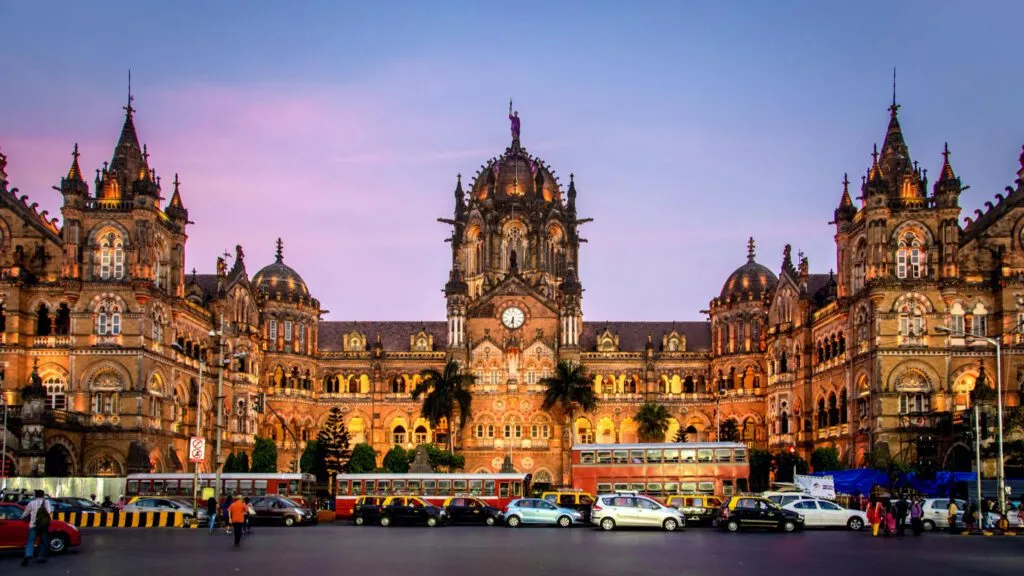Chhatrapati Shivaji Terminus History in Mumbai
Chhatrapati Shivaji Terminus has a long history that began in the eighteenth century. When the British ruled India, the Chhatrapati Shivaji Terminus in Mumbai was known as Victoria Terminus (VT station). During the British Empire, a British architect named Frederick William Stevens designed the Chhatrapati Shivaji Terminus, formerly known as VT Station Mumbai (VT). Its remarkable design and historical significance make it a key part of CST Mumbai history, attracting tourists and history enthusiasts from around the world. It took about ten years to complete the construction of this iconic monument, which began in 1878 for the renowned station. As a result, Chhatrapati Shivaji Terminus is among the iconic Mumbai landmarks, which was finished in 1888. Once the Terminus was completed, it was renamed in honour of Queen Victoria’s Golden Jubilee, an occasion marked by a grand celebration and wonderful tribute in India. Today, Chhatrapati Shivaji Terminus is a testament to Mumbai’s rich history and a vital transportation hub connecting the city to the rest of India. Its legacy as a symbol of the British Raj and its subsequent transformation into a modern railway terminus is evidence of the country’s progress and resilience. The Chhatrapati Shivaji Terminus history reflects not only architectural brilliance but also the evolution of Mumbai as a commercial and cultural hub. As one of the busiest railway stations in India, its design continues to inspire awe among visitors and locals alike. Understanding the Victoria Terminus Mumbai history offers a glimpse into the city’s colonial past and its transformation into a modern metropolis.
Chhatrapati Shivaji Terminus History In The Architecture In Mumbai
Chhatrapati Shivaji Terminus (CST) features a fantastic blend of traditional Indian architectural styles and Victorian Gothic Revival architecture. British architect Frederick William Stevens designed the terminus, which exemplifies the influence of both European and Indian design elements and is a prime example of colonial-era architecture. Its intricate details, towering domes, and ornate stone carvings make Chhatrapati Shivaji Maharaj Terminus architecture a stunning masterpiece.Victorian Gothic Revival:
Frederick William Stevens architect was influenced by the architectural style that gained popularity in nineteenth-century Britain. Pointed arches, ribbed vaults, flying buttresses, and elaborate ornamentation characterize this style. This design contributed significantly to the legacy of British architecture in Mumbai, leaving an enduring mark on the city’s architectural identity.Traditional Indian Architecture:
Stevens skillfully integrated several traditional Indian architectural motifs into the CST design. This blending is especially noticeable in the building’s façade, decorated with intricate stone carvings, sculptures, and Indian motifs. Additionally, the terminus has a sizable central dome modelled after India’s excellent example of Islamic architecture, the Gol Gumbaz in Bijapur.Exterior Features:
The exterior of Chhatrapati Shivaji Terminus is adorned with many sculptures and carvings that demonstrate the artistry of the time. The building’s unique reddish colour comes from sandstone and limestone. Two elaborate octagonal towers flank a grand porte-cochère, or covered entrance for cars, that serves as the terminus’s entrance. Such features highlight the influence of British architecture in Mumbai, demonstrating how colonial design elements were adapted to the Indian context.Interior Features:
Chhatrapati Shivaji Terminus’ interior is equally stunning, with elaborate stained-glass windows, tall, vaulted ceilings, and a grand central staircase. The ticket counters and waiting areas feature ornate woodwork and decorative details, while the main concourse is decorated with elaborate carvings and frescoes. As one of the most iconic landmarks in Mumbai, the station serves as a bustling transportation hub and stands as a testament to the city’s rich architectural heritage.
Functionality Significance of CST
Chhatrapati Shivaji Terminus is one of the busiest railway stations in India, serving as a vital transportation hub for millions of commuters and travellers. It is the headquarters of the Central Railways and handles both long-distance and suburban trains. The station’s strategic location in South Mumbai makes it a crucial point for connectivity within the city and beyond. Surrounded by famous landmarks in Mumbai, such as the Gateway of India and Marine Drive, it is a functional hub and part of the city’s rich architectural and cultural heritage.Suburban Services:
The suburban railway network from Chhatrapati Shivaji Terminus is a lifeline for Mumbaikars. The station sees a constant stream of local trains ferrying passengers to various parts of the city and its suburbs. This network plays a crucial role in the daily lives of Mumbai’s working population, easing their commute and connecting them to different corners of the metropolitan area.Long-Distance Trains:
Apart from suburban services, Chhatrapati Shivaji Terminus is a central terminus for long-distance trains, connecting VT station Mumbai to various cities across India. The station’s extensive rail network facilitates travel to northern, eastern, and southern India destinations, making it an essential part of the country’s rail infrastructure.
Heritage and Cultural Significance: UNESCO World Heritage Site
In 2004, Chhatrapati Shivaji Terminus was declared a UNESCO World Heritage Site, recognizing its outstanding architectural and historical value. The station’s inclusion in this prestigious list underscores its significance as a cultural and architectural landmark, not only for Mumbai tours but for the entire world.Preservation Efforts:
Given its heritage status, numerous efforts have been made to preserve and restore the station’s architectural integrity. Conservation projects have aimed to maintain the original design while incorporating modern amenities to meet contemporary needs. These initiatives ensure that Chhatrapati Shivaji Terminus remains a functional transport hub while retaining its historical charm.Cultural Icon:
Chhatrapati Shivaji Terminus has transcended its role as a railway station to become a cultural icon. It has been featured in numerous films, documentaries, and art projects, symbolising Mumbai’s spirit and resilience. The station’s grandeur and historical significance make it a favourite subject for photographers, historians, and tourists.Modernization and Restoration:
As a UNESCO World Heritage Site, it is crucial to balance modernisation and preserving Chhatrapati Shivaji Terminus’s historical and architectural legacy. In 2016, a major restoration project was undertaken to clean the building’s façade, repair structural damage, and restore the intricate carvings and statues adorning the exterior. This project ensured that the station’s original charm and grandeur were maintained while updating its infrastructure to meet modern demands.Conclusion
Chhatrapati Shivaji Terminus is a living testament to Mumbai’s rich heritage, architectural brilliance, and functional significance. From its inception as Victoria Terminus Mumbai (VT Station Mumbai) to its current status as a UNESCO World Heritage Site, CST has stood the test of time, serving as a vital transportation hub while preserving its historical charm. For those interested in exploring Mumbai’s architectural marvels and rich history, a visit to Chhatrapati Shivaji Terminus is a must. As part of a Mumbai Private Tour, this landmark offers a unique glimpse into the city’s past and present. Additionally, it serves as a key highlight in any Mumbai City Sightseeing & Market Tour, showcasing Mumbai’s vibrant culture and heritage.FAQ,s
Chhatrapati Shivaji Terminus, formerly known as Victoria Terminus (VT Station), was built during the British era and completed in 1888. It reflects Mumbai’s colonial past and architectural grandeur.
The CST building design was created by British architect Frederick William Stevens, combining Victorian Gothic Revival and traditional Indian architectural elements.
It was declared a UNESCO World Heritage Site in 2004 for its architectural brilliance and cultural significance, making it one of Mumbai’s most iconic landmarks.
The CST building design stands out for its intricate stone carvings, towering domes, and a blend of European and Indian motifs, representing colonial-era architectural excellence.
Yes, Chhatrapati Shivaji Terminus is a highlight on many Mumbai Private Tours offered by Magical Mumbai Tours. This allows visitors to explore its historical significance and bustling railway operations.





